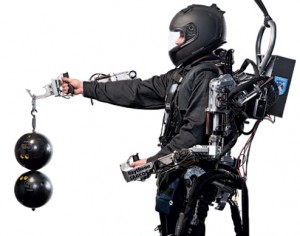Walking Paraplegics and Super Human Strength
One of the most exciting pieces of technology soon to be unleashed on the world has got the be the powered exoskeleton suit. An exoskeleton is “a hard outer structure, such as the shell of an insect or crustacean, that provides protection or support for an organism.” Human’s are naturally equipped with an endoskeleton, but imagine the possibilities if we could have both?
That concept has now become a reality, as scientists and the military alike are fine tuning separate versions of what is being called a wearable exoskeleton. This piece of future tech is exciting for two very different, but equally awesome reasons. The first reason is to greatly enhance the lives of the less fortunate, those who have lost the ability to use their legs. There are three major companies designing a form of wearable exoskeleton, with the ambitious goal of replacing the wheelchair. The all too true reality of ‘never walking again’ for many is now being thrown out the window. Check out this short, but amazing video below.
The weight of the device, usually 45-70 pounds, is transferred to the ground instead of being handled by the wearer. The model above is called the ReWalk. A rival model called the ‘Ekso’, created by a company called Ekso Bionics, can be adjusted in minutes to fit any patient between 5’2″ and 6’2″ and weighing under 220 pounds. Ekso Bionics actually within the last week delivered the first commercial model of the wearable exoskeleton suit to be used at Craig Hospital in Denver, Colorado. A woman is also planning on using the ReWalk suit to complete the London Marathon in April of this year. Pretty remarkable stuff.
Aside from the amazing potential above, the other major application for this future tech is with the military. These exoskeleton suits are being formatted to give mere mortals superhuman strength. This powered exoskeleton is quickly bridging the gap between man and iron man; between human and superhuman.
The suit features pressure sensors connected to a computer, which can anticipate what action the user wants to do. This technology enables the suit to mimic the particular action (lifting, pushing, pulling) before any force is exerted; the user does not feel the impact of any of the weight! An operator wearing an Exoskeleton suit can lift hundreds of pounds, hundreds of times without breaking a sweat.
The eventual goal is for a select group of soldiers to sport this wearable tech in the battlefield, being able to carry hundreds of pounds of weapons and cargo while running and jumping through treacherous terrain.
While mild-blowing and futuristic even today, a similar idea was patented in 1890, and a concept similar to what we’re seeing today was engineered in the 1960′s by General Electric. GE created a prototype called Hardiman, which increased human strength by a factor of 25. When the wearer had the suit on, he could lift 500 pounds, while only feeling the strain of 20! The problems, though, were several. The suit weighed 1,500 pounds, and would behave violently when pushed to capacity, so it was actually never tested with a human inside.
There are still a few kinks to be worked out with the exoskeleton suit of today. There are few external power supplies that can operate the mechanism for more than a few hours. The military grade version is still fairly heavy, and researchers are looking for more lightweight materials to be used in the future. Having precise movements is the third and final major hurdle for the wearable robot. It’s not easy to match up the human brain with the capabilities of a machine, but we’re trying.
The real world applications for this type of technology are potentially limitless. Firefighters would be in heaven inside an exoskeleton; they’d be able to lift cumbersome debris and carry several survivors out of danger at once. Similarly, imagine a construction zone where workers become hybrid machines, able to effortlessly maneuver almost anything on site. The sky is the limit.
Comments
Tags: bionic suit, ekso bionics, Exoskeleton, Exoskeleton Suit, Hardiman, Military, paraplegics walk, Powered Exoskeleton, rewalk, superhuman strength, wearable robot
Trackback from your site.


Comments (1)
Maven
| #
Amazing application opportunities, it reminds me of the song “In the year 2525″ http://www.youtube.com/watch?v=5tLTb4P1HD8. “You won’t find a thing to do, some machine’s doin’ that for you”.
Reply